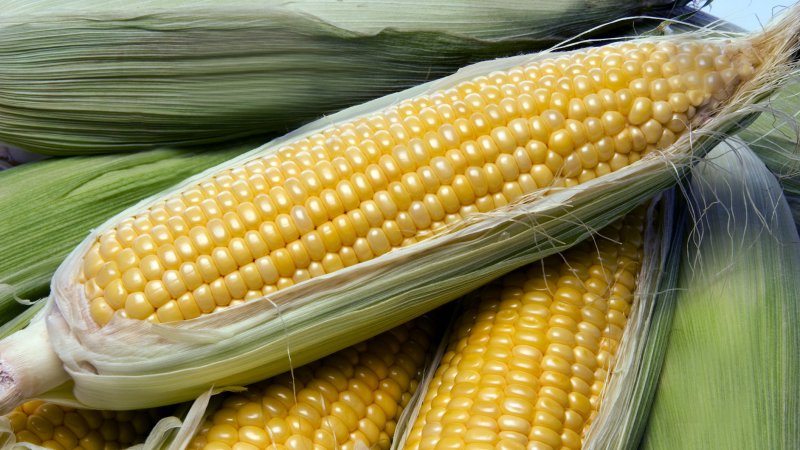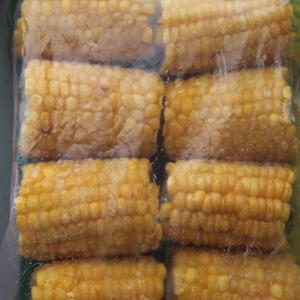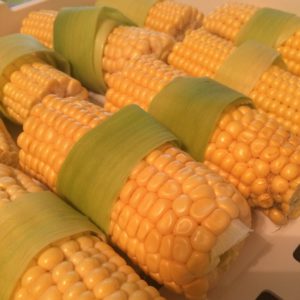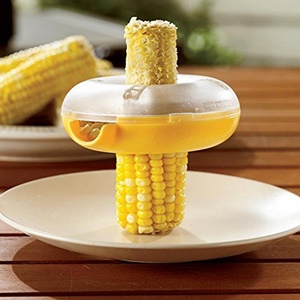How to freeze corn on the cob at home: storage options and tips from experienced housewives
Corn is a seasonal plant, after harvest it can be bought mainly in canned or dried. Experienced housewives recommend freezing it on the cob, as this method retains most of its useful qualities. Frozen cereals, like fresh ones, have a caloric content of about 90 kcal per 100 g. The overwhelming part of the composition is water - 70–75%. Carbohydrates make up 20-23%, proteins 3-3.5%, and fats up to 1% by weight. Dietary fiber also accounts for about 2% of the grain mass.
Due to the content of vitamins, macro- and microelements, the use of frozen corn helps to improve the functioning of the heart and blood vessels, digestive organs, nervous and endocrine systems. As part of a varied diet, it improves the appearance, health of the skin and hair, and stabilizes metabolic processes. Consider how to freeze corn on the cob at home
The content of the article
Is it possible to freeze corn on the cob
Frozen corn on the cob is a simple preparation for the winter that will help preserve the product for a long time. After defrosting and boiling, you can enjoy the tasty and juicy cereal, just like in summer.
Will taste and beneficial properties be lost
Freezing corn on the cob helps to preserve not only the beneficial properties, but also the taste of the fresh plant. Cereal grains contain B vitamins, magnesium, phosphorus, iodine, potassium and calcium. The use of the product has a positive effect on the functioning of the gastrointestinal tract and the immune system in general.
In frozen vegetables, fruits and berries, nutrients are preserved better than in their canned counterparts. In addition, it is very tempting to have the opportunity to feast on products in the winter, as if they had just been removed from the garden.

Maize preparation
Before freezing the cob, you need to properly prepare:
- remove integumentary leaves;
- remove stigmas (brown hairs);
- cut off the tip with unripe seeds by 2-3 cm;
- remove all damaged areas with a sharp knife.
Rinse each ear under running water, pat dry with a towel, or leave to dry at room temperature.
Correct selection of cobs
The main thing when harvesting corn is to choose quality specimens. Fresh ears should be frozen. If the crop has been stored for a long time, then the sugar contained in the cereal turns into a starchy substance, which spoils the taste.
Choose cobs of medium ripeness. Unripe and overripe options will not give the taste that children and adults like so much. The ears should be free of visible damage, dark spots and insect marks.
Which varieties are best for
Sugar varieties are excellent for freezing, ripeness should be milky-wax. When pressure is applied to the pale yellow soft corn grain, the sweet white juice emerges, the corn is ripe.
Reviews of housewives about the nutritional qualities of corn after freezing are controversial. But not always the reason for failure is associated with a violation of the procurement technology. Most sweet corn varieties are not designed for storage other than canning.
Only 5 varieties are capable of preserving the pleasant taste of grains after freezing:
- Merkur;
- Nika 353;
- Zukerka;
- Chell;
- Fun.
Nuances of freezing ears
You can freeze the ears in different ways. But in any case, more space is required in the freezer than when harvesting grains. However, the result is worth it.
Raw
When frozen raw, the benefits are:
- useful substances are preserved as much as possible;
- you can boil corn cobs in the cold season and feast on it right from the head.
The disadvantages include the fact that the ears need to be fully cooked for 30–40 minutes after defrosting.
Boiled
If you freeze boiled ears, then the product can be eaten immediately after defrosting. A kind of "hardening" of boiled corn before freezing will preserve all the useful properties, taste and appearance. But it will take more time to prepare the product.
Step-by-step instructions for processing, packaging and freezing
The dry and hardened process will differ. Each of the methods has its own advantages and disadvantages, but nevertheless allows you to preserve the beneficial substances and aroma of the vegetable.
Dry method
Pack the prepared ears in bags of 2–4 pieces (by removing air from them and fastening them with a zip-fastener) or wrap each head of cabbage separately with cling film. As such, place the ears in the freezer. In winter, all you have to do is get the corn out of the refrigerator, put it in boiling water and cook for 20-30 minutes. We recommend putting in one bag as many ears as you use at a time. Re-freezing is undesirable.
Hardening method
The blanching method is called a kind of product hardening. The sequence of actions for this method is as follows:
- Prepare two pots - boiling water and cold water (ice cubes can be added).
- Put the prepared ears in hot water for 5 minutes. During cooking, all heads of cabbage should be completely immersed in water. They can be turned over if necessary.
- Then transfer to a pot of cold water for 3 minutes.
- Repeat the procedure 3-5 times.
- Spread the ears on a thin, lint-free towel and wait until they dry well.
- Then wrap each fruit separately with cling film and place in the freezer.
Storage periods
The speed of freezing corn on the cob depends on the refrigerator. On average, it freezes in 2-3 hours. If you are packing several ears of corn in one bag, then you can put them on a dish and place them in the chamber for a day, and then pack them. In this case, you will not have a large frozen lump.
Frozen vegetables usually have a shelf life of one year, but corn is an exception and should be kept in the freezer for up to 6-8 months, whether blanched or not.
Advice! Do not delay the consumption of corn cobs for food. It is advisable to eat stocks before the next harvest: the longer the grain is stored, the less pronounced the taste and aroma of the grains becomes, and the harder their structure
Optimal conditions
The grains easily absorb foreign aromas. Since the freezer does not always store only vegetables, but also meat or fish, you need to isolate the cob from air access, trying to achieve maximum tightness of the package.
How to defrost corn cobs
It is best to defrost the corn by placing it in the refrigerator. So the process will take place gradually, but the correct temperature regime will remain, which will not allow bacteria to develop. You can defrost the ears in the microwave, but to do this, you need to wrap them with a towel so that the kernels do not dry out, but remain soft and juicy.
Corn on the cob, which has not been previously blanched, is recommended to partially defrost and only then send to cook in a saucepan.It's not a good idea to reheat frozen food by simply leaving it at room temperature, as bacteria can develop in it.
Attention! Frozen corn should not be immersed in hot water, believing that it will melt during the cooking process. This will make the beans tasteless.
Further application
After defrosting, raw ears are boiled in boiling water for 20-30 minutes. Pre-blanched corn should be kept in boiling water for several minutes.
Thawed corn can not only be boiled, but also cooked in the oven. To do this, mix butter (20 g per 1 ear) with herbs and spices (to taste). The heads of cabbage are coated with the resulting marinade, wrapped in foil and sent for 40 minutes to an oven preheated to + 180˚C.
Corn goes well with many foods, so it can be added to almost any treat. Salads and snacks with delicate grains will always decorate the festive table and daily meal.
Tips & Tricks
To enjoy eating frozen corn, follow these simple guidelines:
- Late crop varieties harvested at the stage of milk maturity stay fresh longer. The skin on the grains is not so rough, but strong enough not to burst during processing.
- Do not leave cereals in the refrigerator without a bag or container. Without packaging, the shelf life of the ears will be reduced by one third.
- Frozen corn is cooked much faster than fresh corn.
- Ensure complete tightness of the package, otherwise the grain will certainly absorb foreign odors during storage.
- Do not cook the cobs frozen. If you put them directly into boiling water, the skin of the grains will become too tough. Wait until they are completely thawed.
- Thawed heads of cabbage can not only be boiled, but also baked in the oven.
Read also:
Why is a cotton scoop on corn dangerous?
Sweet corn: choosing the best variety and growing it correctly.
Conclusion
The seasonality of corn ripening does not allow to feast on delicious cereals all year round. Preservation does not preserve all the nutrients and vitamins of the product. Freezing the ears is a great way to completely preserve flavor and nutritional content. This method requires young, ripe sugar cobs.
You can choose any of two methods of cryopreparation - dry method and using hardening (blanching). Dry less laborious, but after defrosting the cobs will have to be boiled. After hardening, keep in boiling water for only a few minutes.
Once you've thawed corn cobs from the freezer in the refrigerator or microwave, you just have to cook them. Corn boiled after freezing will have the same taste and aroma as freshly picked from the garden.